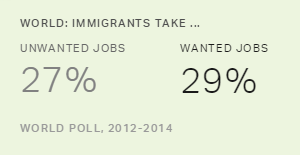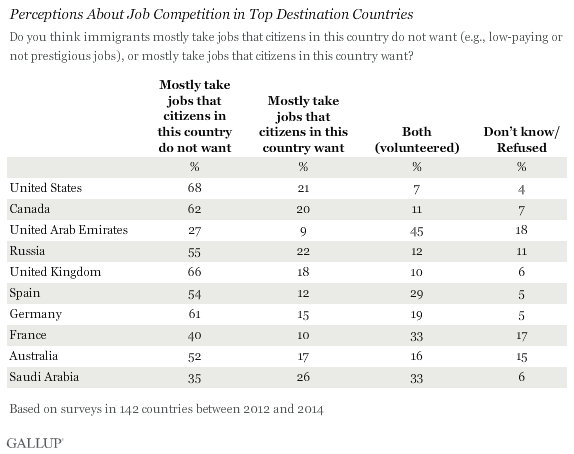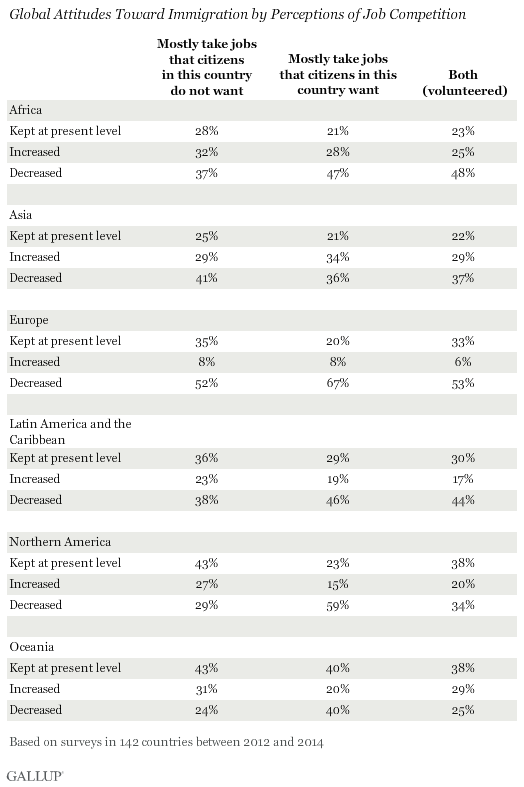Story Highlights
- Concern evident in all countries, people generally divided
- 58% in high-income economies think immigrants take unwanted jobs
- In other economies, more think immigrants take wanted than unwanted jobs
WASHINGTON, D.C. -- In all of the 142 countries Gallup surveyed as part of its study of attitudes toward immigration, there is at least some level of concern that migrants take jobs away from native workers. Worldwide, adults are generally split on whether they think migrants mostly take the low-paying or low-prestige jobs that citizens in their countries do not want to do (27%) or mostly take jobs that citizens do want (29%). Another 18% think both may be happening in their countries.

However, these results vary considerably in low- and middle-income economies versus high-income economies. Residents of high-income economies overall are much more likely to say immigrants take jobs citizens do not want (58%) than to say they take jobs citizens want (17%). In all other economies, residents are more likely to say immigrants take the jobs that citizens want.
These findings are among those featured in the International Organization for Migration's new report, How the World Views Migration, which is based on Gallup World Poll interviews with more than 183,000 adults across 142 countries between 2012 and 2014. Adults worldwide were asked two questions about immigration: "In your view, should immigration in this country be kept at its present level, increased or decreased?" and "Do you think immigrants mostly take jobs that citizens in this country do not want (e.g., low-paying or not prestigious jobs), or mostly take jobs that citizens in this country want?"

The clear divide between high-income economies and low-/middle-income economies regarding opinions on job competition largely explains the differences in perceptions at the regional level. In Africa, Latin America and the Caribbean, and developing Asia, which are home to many low- and middle-income economies, the perceived job rivalry between migrants and native workers is acute. Adults in each of these regions are nearly twice as likely to believe that migrants take jobs that citizens in their countries want as they are to believe migrants take jobs that citizens do not want.
In regions where high-income economies are prevalent, including Northern America, Oceania, developed Asia, and Europe, majorities are more likely to say migrants mostly take the jobs that their citizens do not want, rather than jobs citizens want.
In all top 10 international migrant destination countries -- all of which are also high-income economies -- many more respondents say immigrants take jobs that residents do not want than say immigrants take jobs that residents want. This is true in United Arab Emirates, a top 10 country, as well, but UAE stands out because more respondents volunteered "both" than gave any of the other responses. A possible explanation for this is that migrants make up the majority of the UAE's private-sector workforce and that the country attracts both high- and low-skilled labor from abroad.

Competition for Jobs Blunts Desire for More Immigration
Generally, people who do not see immigrants as competitors for jobs tend to be more open to immigration in their countries. In Africa, Europe, and Latin America and the Caribbean, for example, people who believe that migrants do not take jobs that citizens want are more positive toward immigration; they are less likely to want to see immigration levels decreased and are more likely to believe immigration levels should be kept the same. In Northern America and Oceania, adults who think migrants take jobs citizens do not want are also more likely to want to see immigration levels increased.

Asia represents an exception. In some countries, notably China (which strongly affects the regional average), residents who think migrants take jobs that citizens want are more positive about immigration levels; in other countries, such as Japan, the opposite relationship exists; and in some -- namely, India -- there is no relationship.
Implications
All of this suggests that perceived competition for jobs does blunt the desire for increased immigration, but also that economic factors do not wholly explain people's attitudes toward immigration. Everywhere in the world, substantial percentages of people think migrants take the jobs that citizens do not want but still want to see immigration levels decreased. This demonstrates how attitudes toward immigration may also be rooted in a country's history and culture, illustrating the further complexities that policymakers must grapple with beyond the economic implications of migration policy, particularly when migrants provide a much-needed source of labor.
Frank Laczko and Marzia Rango of IOM were contributing authors to the How the World Views Migration report.
Survey Methods
Gallup conducted a total of 183,772 interviews in 2012, 2013 and 2014. Most data for this report were collected in 2012 and 2013. In 2014, data were collected for Canada, Australia, Hong Kong, China, Switzerland and Norway. For this report, typically 1,000 interviews were done per country. A few countries such as India and China had higher sample sizes (more than 2,500 each), and all former Soviet Union countries included multiple survey administrations with a minimum of 1,000 interviews per administration.
With some exceptions, all country samples are probability based and nationally representative of the resident population aged 15 and older. The coverage area is the entire country, including rural areas, and the sampling frame represents the entire civilian, non-institutionalized, aged 15 and older population of the country. Exceptions include areas where the safety of interviewing staff is threatened, scarcely populated islands in some countries, and areas that interviewers can reach only by foot, animal or small boat. In Gulf Cooperation Council countries, at the time of data collection, Gallup was able to interview only nationals and Arab expatriates.
Telephone surveys are used in countries where telephone coverage represents at least 80% of the population or is the customary survey methodology. In Central and Eastern Europe, as well as in the developing world, including much of Latin America, the former Soviet Union countries, nearly all of Asia, the Middle East and Africa, an area frame design is used for face-to-face interviewing.

